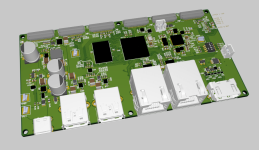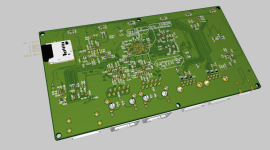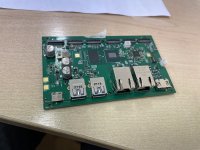I paid €21.38 for my USB DAC that has this chip inside. And that's including shipping from china and german sales tax. Hard to imagine how they do it, considering the DAC chip alone goes for €17.52 in quantities of 4000.Price coming down now too.
https://www.digikey.co.uk/en/products/detail/cirrus-logic-inc/CS43131-CNZR/7388593
Was about half that price that 2 years ago. I ended up buying the cheapest USB with the QFN parts from Amazon. Salvaged the four chips I needed for testing.
End goal is a set of boards to drop into my busted Meridian 568.2 with room correction, hdmi & atmos outputs. It's been with me for 20 years so time for a refit!So what are your plans with this board, if I may ask?
I'll be making a new rear panel etc.
Second board will be used in a 562 enclosure - that will have a load of I/O over or multichan spdif or something. I was looking for firewire controllers and how to interface with the 8m plus... 🙂
Pics from meridian-audio.info
562v2 rear
That's the long term goal anyway. Still thinking...
Last edited:
CamillaDSP or filters in Pipewire
The 8M Plus ASRC is available as an asla plugin - but limited functionality to what the ASRC unit is capable of.
I believe it can also perform many taps per channel too!
https://github.com/nxp-imx/imx-alsa-plugins
Google - NXP EB808 - for comprehensive performance report
"Vybrid ASRC Performance Audio Analyzer Measurements"
Better than 120dB THD, 144dB SNR.
NXP Linux Yocto Project BSP for Desktop PoC (Proof of Concept)
https://github.com/nxp-imx/meta-nxp-desktop/tree/lf-5.15.71-2.2.0-kirkstone
Last edited:
The plugin supports up to three streams with a total of ten channels, just like the spec sheets say, or am I missing something?The 8M Plus ASRC is available as an asla plugin - but limited functionality to what the ASRC unit is capable of.
My filters are quite long at 65536 taps per channel. Earlier in the thread you mentioned 128 taps per channel, that would not work. I don't think the CPU would have a problem with a few of those extra long filters, though. A CPU based approach would have the advantage of being generic enough that there is no hard dependency on one specific type of SoC.I believe it can also perform many taps per channel too!
https://github.com/nxp-imx/imx-alsa-plugins
For my endeavours I always try to avoid non-standard solutions because I don't have much leisure time to invest. I prefer getting something going with off the shelf solutions that waste a few CPU cycles to not getting anything working at all.
Last edited:
The hardware IP is a different beast in the 8M Plus series. Max floating point performance is about 800*10^6. Powerful, but defintely not enough for 65k taps for many channels.The plugin supports up to three streams with a total of ten channels, just like the spec sheets say, or am I missing something?
Off board. This is a tiny SBC and not really an all in one + supplies. For a small DC to opamp supply i've had good results with the R1283K001C into a Cmultiplier. Something like.You have 5V only at the connectors. How do you want to generate the opamp supplies?
https://www.nisshinbo-microdevices.co.jp/en/pdf/datasheet/r1283-ea.pdf
Prototype board I made a while ago....
DDR4 routed! Working on I/O again now.
I had to reduce the i2s by a channel pair I was not able to source eth ICs so had to go with higher pin count eth = less one less set of i2s pads.
SAI1 - rx pins 6 & 7 had to be moved to support ETH ports.

I had to reduce the i2s by a channel pair I was not able to source eth ICs so had to go with higher pin count eth = less one less set of i2s pads.
SAI1 - rx pins 6 & 7 had to be moved to support ETH ports.
Last edited:
99% complete. Plenty of room for dfn logic buffers at the i2s I/O.
I have also been considering the Cirrus CS2x00 series for extracting clean clock from AVB/TSN.
I have also been considering the Cirrus CS2x00 series for extracting clean clock from AVB/TSN.
Updating the models and silks. Had to change a few BoM items to parts available to me.
@ariendj - assuming the sample boards work out I can send you one for testing. It might be early July.
I hope to be in a position to order the first boards next week.
I've left enough room near the USB-C power in port to implement a filter arrangement like
https://www.we-online.com/components/media/o150133v410 ANP007d EN.pdf


@ariendj - assuming the sample boards work out I can send you one for testing. It might be early July.
I hope to be in a position to order the first boards next week.
I've left enough room near the USB-C power in port to implement a filter arrangement like
https://www.we-online.com/components/media/o150133v410 ANP007d EN.pdf


Do you plan to boot from SD Card or do you have an eMMC memory on your board too?
If you plan to do more boards it is not advisable to use a SD Card for booting!
We had alot of trouble in the past doing so.
If you plan to do more boards it is not advisable to use a SD Card for booting!
We had alot of trouble in the past doing so.
Some debugging of power rails.
I used the PMIC output to activate the pre PMIC power switch. Oops! Had to enable the power switch transistor with a wire.
We now have power at all the rails at correct voltages.

I used the PMIC output to activate the pre PMIC power switch. Oops! Had to enable the power switch transistor with a wire.
We now have power at all the rails at correct voltages.
Step 2 : HDMI signal, active !
Step 3 :
Hope that it boots ...
Step 3 :
- Linux OS kernel image (zImage/Image)
- Device tree file (*.dtb)
- Bootloader image
- Root file system (for example, EXT4)
Hope that it boots ...
Cirrus CS2x00 are going to be discontinued soon.
Nice work btw! Did you use uVIAs or how did you handle the small pitch?
Nice work btw! Did you use uVIAs or how did you handle the small pitch?
- Home
- Source & Line
- Digital Line Level
- LDSP - audio optimised i.MX 8M Plus QuadLite
